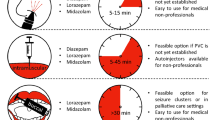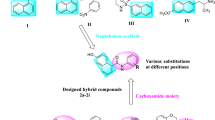Abstract
Some new substituted hydrazone derivatives were designed, synthesized, and evaluated for anticonvulsant activity and neurotoxicity. The anticonvulsant activity was established after intrapentoneal administration in one-seizure models, which include maximal electroshock seizure (MES) model. In the MES screen, the most active compounds were PK-1 and PK-2 which showed 100 % protection. None of these compounds showed neurotoxicity. A computational study was also performed including prediction of pharmacokinetic properties, bioactivity, toxicity, and docking studies. The result reveals from the computational studies as the protein–ligand interaction energies of derivatives PK-1 and PK-2 with established epilepsy receptor namely Na/H exchanger were −8.31 and −7.30 kcal/mol, which is slightly higher than the phenytoin as −6.71 kcal/mol. The percentage of absorption (%ABS) was calculated and observed that all titled compounds exhibited a better %ABS ranging 82–90. Therefore, all pharmacological parameters are almost similar to standard drug. The above observation suggested that these compounds would serve as better lead compounds for anticonvulsant screening for future drug design perspective.




Similar content being viewed by others
References
Abdel-Aal MT, El-Sayed WA, El-Ashry EH (2006) Synthesis and antriviral evaluation of some sugar aryl glycinoylhydrazones and their oxadiazoline derivatives. Arch. Pharm. Chem. Life Sci 339:656–663
Bukowski L, Janowiec M (1996) 1-Methyl-1H-2-imidazo [4,5-b]pyridinecarboxylic acid and some of derivatives with suspected antituberculotic activity. Pharmazie 51:27–30
Camerman A, Camerman N (1980) Stereochemical similarities in chemically different antiepileptic drugs: mechanism of action. Raven Press, New York, pp 223–231
Chang BS, Lowenstein DH (2003) Epilepsy. N Engl J Med 349(13):1257–1266
Dimmock JR, Vashishtha SC, Stables JP (2000) Anticonvulsant properties of various acetylhydrazones, oxamoylhydrazones and semicarbazones derived from aromatic and unsaturated carbonyl compounds. Eur J Med Chem 35:241–248
El-Hawash SAM, Abdel Wahab AE, El-Dewellawy MA (2006) Cyanoacetic acid hydrazones of 3-(and 4-)acetylpyridine and some derived ring systems as potential antitumor and anti-HCVagents. Arch. Pharm. Chem. Life Sci 339:14–23
Ergenc N, Gunay NS (1998) Synthesis and antidepressant evaluation of new 3-phenyl-5-sulfonamidoindole derivatives. Eur J Med Chem 33:143–148
Fraga AGM, Rodrigues CR, Miranda ALP, Barreiro EJ, Fraga CAM (2000) Synthesis and pharmacological evaluation of novel heterocyclic acylhydrazone derivatives, designed as PAF antagonists. Eur J Pharm Sci 11:285–290
Kuçukguzel SG, Rollas S, Erdeniz H, Kiraz M (1999) Synthesis, Characterization and Antimicrobial Evaluation of Ethyl 2-Arylhydrazono-3-oxobutyrates. Eur J Med Chem 34:153–160
Loscher W (1998) New visions in the pharmacology of anticonvulsion. Eur J Pharmacol 342:1–13
McNamara OJ (2001) Drugs effective in the therapy of the Epilepsy. In: Hardman JG, Gilman LC (eds) The Pharmacological basis of therapeutical. McGraw-Hill, New York, pp 521–548
MolinspirationCheminformatics, Bratislava, Slovak Republic (2010) http://www.molinspiration.com/services/properties.html. Accessed 16 Aug 2010
Pandey J, Pal R, Dwivedi A, Hajela K (2002) Synthesis of some new diaryl and triaryl hydrazine derivatives as possible estrogen receptor modulators. Arzneimittelforschung 52:39–44
Pandeya SN, Raja AS, Stables JP (2002) Synthesis of isatinsemicarbazones as novel anticonvulsants–role of hydrogen bonding. J Pharm Pharm Sci 5(3):266–271
Pereira LH, Coelho PM, Costa JO, de Mello RT (1995) Activity of 9-acridanone-hydrazone drugs detected at the prepostural phase, in the experimental schistosomiasismansoni. Mem Inst Oswaldo Cruz 90:425–428
Perucca E, Bialer M (1996) The clinical pharmacokinetics of the newer antiepileptic drugs. Focus on, topiramatezonisamide and tiagabine. Clin Pharmacokinet 31:29–46
Schmidt D, Stavem K (2009) Long-term seizure outcome of surgery versus no surgery for drug-resistant partial epilepsy: a review of controlled studies. Epilepsia 50:1301
Singh V, Srivastava VK, Palit G, Shanker K (1992) Coumarin congeners as antidepressants. Arzneimittelforschung 42(8):993–996
Todeschini AR, Miranda AL, Silva CM, Parrini SC, Barreiro EJ (1998) Synthesis andevaluation of analgesic, antiinflammatory and antiplatelet properties of new 2-pyridyl aryl hydrazone derivatives. Eur J Med Chem 33:189–199
Tripathi L, Singh R, Stables JP (2011) Design & synthesis of N-[substituted] pyridine-4-carbohydrazides as potential anticonvulsant agents. Eur J Med Chem 46:509–518
Walcourt A, Loyevsky M, Lovejoy DB, Gordeuk VR, Richardson DR (2004) Novelaroylhydrazone and thiosemicarbazone iron chelators with anti-malarial activity againstchloroquine-resistant and -sensitive parasites. Int J Biochem Cell Biol 36:401–407
Wong MG, Adefina J, Andrew PR (1986) Conformational analysis of clinically active anticonvulsant drugs. J Med Chem 29:562–572
Lin Z, Kadaba PK (1997) Molecular targets for the rational design of antiepileptic drugs and related neuroprotective agents. Med Res. Rev 17(6):537–572
Zhao Y, Abraham MH, Lee J, Hersey A, Luscombe NC, Beck G, Sherborne BI (2002) Rate-limited steps of human oral absorption and QSAR studies. Pharm Res 19:1446–1456
Acknowledgments
The authors would like to express their gratitude to IIT Roorkee, Delhi University Delhi, and IIT Delhi for providing the spectral and elemental data. One of the authors (Praveen Kumar) is thankful to S. D. College of Pharmacy and Vocational Studies, Muzaffarnagar, India for providing research facilities.
Author information
Authors and Affiliations
Corresponding author
Rights and permissions
About this article
Cite this article
Raj, V., Kumar, P. & Kumar, A. Design and synthesis of 4-(4-ethyl-phenyl)-4-oxo-butyric acid (3-oxo-1, 3-diphenyl-propylidene)/[1-(4-chloro-phenyl)-ethylidene]-hydrazide as potential anticonvulsant agents. Med Chem Res 24, 603–610 (2015). https://doi.org/10.1007/s00044-014-1154-2
Received:
Accepted:
Published:
Issue Date:
DOI: https://doi.org/10.1007/s00044-014-1154-2




